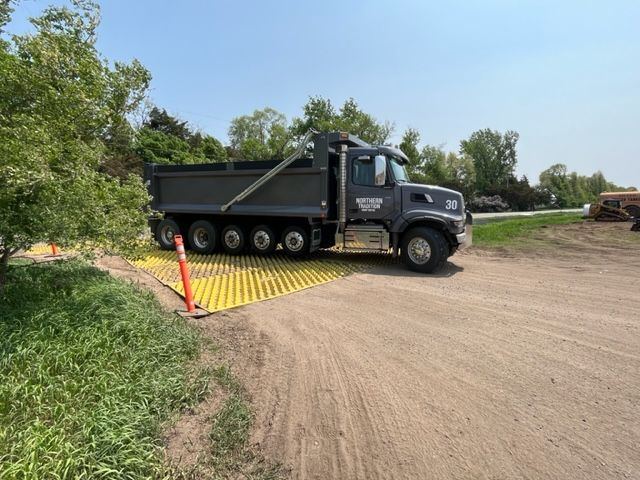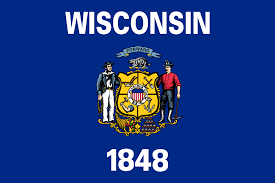Wisconsin Trackout Control BMPs
The Wisconsin DNR administers Wisconsin's Pollutant Discharge Elimination System (WPDES) program under delegation of the Clean Water Act and issues stormwater permits to contractors, municipalities, and industrial sites. Applications for stormwater permits are completed online, and various resources are provided to inform the construction and post-construction Best Management Practices (BMPs) that will be used. Construction projects that apply for the WPDES Construction Site Storm Water General Permit (Permit No. WI-S067831-6) must submit an Erosion Control & Storm Water Management Plan. The DNR has developed erosion and sediment control technical standards to assist landowners and contractors in developing a construction site erosion control plan.
Construction Site Erosion & Sediment Control Standards
The DNR's technical standards inform contractors about the techniques proven to meet Wisconsin’s erosion and sediment control requirements.. The Standards include various BMPs for preventing erosion, including specifications for Silt Fences, Storm Drain Protection, Construction Site Dust Control on Construction Sites (Technical Standard 1068), Seeding, Grading Practices, and Trackout Control Practices.
BMPs: Trackout Control Practices
In alignment with Wisconsin's WPDES construction storm water requirements, the stated purpose of Trackout Control Practices is to "identify common methods which may be used to prevent, reduce, and/or mitigate the tracking of sediment." The Wisconsin DNR identifies three methods to minimize trackout:
- Prevent trackout with stabilized work surfaces and reduced vehicle contact with soil.
- Reduce trackout with a stone tracking pad, manufactured trackout control devices, or tire washing.
- Mitigate trackout with street cleaning.
FODS Trackout Control Mats fall directly under the second method, as they are an approved manufactured trackout control device recognized by the Wisconsin DNR under Technical Standard 1057.
WisDOT & DNR Construction Entrance Detail
The Wisconsin DOT works with the DNR's Environmental Analysis and Sustainability Program (EAS) for stormwater and environmental coordination on transportation projects. Each transportation project will contact a transportation liaison. The DNR-established BMP manuals and standards are used for WisDOT projects across the state.
The use of stone-tracking pads is the traditional method for minimizing trackout on construction sites. The DNR standards specify the dimensions of the stone tracking pads and the type of stone to be used on the entrances.
The DNR detail indicates that stone tracking pads consist of at least a 12" layer of rock, which may be installed over a geotextile fabric where warranted due to soil type or high groundwater. The DNR gradation requires all stone used on the tracking pad to be 3 inches or smaller, with at least 90% of the material 2-1/2 inches or smaller. The tracking pad must be at least 50' long and should be either the full width of the access point or at least 12' wide if exiting traffic is restricted to a dedicated egress lane. Surface flows should be diverted away from tracking pads, and runoff from tracking pads should be contained using sediment control practices.
When compaction occurs, scraping, loosening, or top-dressing with additional aggregate may be required to maintain the effectiveness of the tracking pad. If effectiveness is not restored by these means, the geotextile and stone must be replaced. Adding stone to an entrance is often required due to traffic and rain events.
FODS Reusable Construction Entrance: Manufactured Trackout Control Device Detail
FODS Construction Entrance Mats consist of a single layer of 12' wide and 7' long mats, which are linked together and staked to the ground. The tops of the mats are formed into a geometric pattern of pyramids, which deform tires and allow sediment trapped in the tire tread to fall to the base of the mat. Sediment at the base of the mat does not come into contact with subsequent vehicles, allowing FODS to continue to perform even in heavy traffic. The pyramids are staggered in the direction of travel, which ensures all areas of the tires are cleaned.
FODS reusable construction entrance mats are designed to replace traditional stone tracking pads. According to DNR Technical Standard 1057, manufactured trackout control devices should be deployed at a minimum device length of 32 feet. Add length if needed to reduce trackout in adverse conditions.
Maintenance is required when 2.5" of sediment builds up at the base of the mats. Maintaining mats is accomplished by simply removing sediment using a FODS shovel. The FODS shovel is designed to fit between rows of pyramids, enabling quick sediment removal. Alternative cleaning methods include using a skid steer with a broom attachment, a street sweeper with an adjustable brush head, or a pressure washer equipped with proper runoff containment, as required by WPDES.
Wisconsin DNR Approved Use Of FODS Trackout Control Mats
The Wisconsin DNR allows the use of manufactured trackout control devices that meet Technical Standard 1057. FODS meets these criteria and is used on projects throughout the state. The Conservation Practice Standard - Trackout Control Practices 1057 lists design criteria for establishing stabilized construction entrances and specifies a minimum length of 32' of manufactured trackout control devices, and advises installing per manufacturer recommendations.
Contractors can benefit from using the FODS Trackout Control System on their projects. The System is practical, lightweight, and can significantly reduce the costs of minimizing trackout.
Please contact us to learn more about using FODS in Wisconsin.
Additional Resources:
Wisconsin DNR Technical Standards
Technical Standard 1057: Trackout Control Practices

